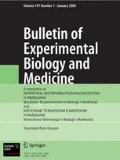Summary
Stable R-variants ofE. coli andS. aureus were produced at a temperature of 45°.
A study was carried out on the effect of a temperature of 45° on the process of acetylation and on the content of citric and lactic acids in S- and R-forms of given strains. In addition, the effect of malonic acid on the growth of microbes was also studied.
It was established as a result of the experiments that under the action of supraoptimal temperature the process of acetylation is depressed and glycolysis is markedly intensified in the S-forms ofE. coli. The R-variants of these strains have shown a certain increase in acetylation, as well as a simultaneous increase in the content of citric and lactic acids. Malonic acid produced the greatest inhibitory effect on the growth of R-forms.
Similar content being viewed by others
Literature Cited
N. N. Zhukov-Verezhnikov and A. P. Pekhov, Genetics of Bacteria [in Russian], Moscow (1963).
A. A. Imshenetiski, Microbiological Processes at High Temperatures [in Russian], Moscow-Leningrad (1944).
A. A. Imshenetskii, Doklady Akad. Nauk SSSR, Vol. 73, No. 5 (1950), p. 1045.
V. S. Mitina, Trudy Saratovsk. Med. Inst., Vol. 26 (1959), p. 248.
E. N. Mishustin, Thermophilic Microorganisms in Nature and Practice [in Russian], Moscow-Leningrad (1950).
L. P. Nikolaeva and A. V. Andryushechkina, Trudy Saratovsk. Med. Inst., Vol. 26 (1959), p. 233.
A. P. Safronov, Biokhimiya, No. 1 (1959), p. 123.
M. B. Atten, J. Gen. Physiol., Vol. 33 (1950), p. 205.
S. B. Barker and W. H. Summerson, J. Biol. Chem., Vol. 138 (1941), p. 535.
L. Clegg and S. Jacobs, In: Adaptation in Microorganisms [Russian translation], Moscow (1956), p. 465.
A. Gaiginschi, V. Petreanu, S. Timosca et al., Arch. Roum. Path. Exp., Vol. 22 (1963), p. 617.
R. E. Handschumacher, G. C. Mueller, and F. M. Strong, J. Biol. Chem., Vol. 189 (1951), p. 335.
G. M. Hills and E. D. Spurr, J. Gen. Microbiol., Vol. 6 (1952), p. 64.
C. N. Hinshelwood, The Chemical Kinetics of the Bacterial Cell, Oxford (1946).
H. A. Krebs, Biochem. J., Vol. 32 (1938), p. 113.
H. A. Krebs, In: The Strategy of Chemotherapy [Russian translation], Moscow (1960), p. 126.
H. C. Lichstein and W. J. Begue, Proc. Soc. Exp. Biol., Vol. 105, New York (1960), p. 500.
Petragnani, In: Atti del 4 Congresso Nazionale di Microbiologia, Milano (1932), p. 153.
Rights and permissions
About this article
Cite this article
Kulyash, Y.V. Effect of a supraoptimal temperature on dissociation of certain species of microorganisms. Bull Exp Biol Med 62, 799–801 (1966). https://doi.org/10.1007/BF00805277
Received:
Issue Date:
DOI: https://doi.org/10.1007/BF00805277



